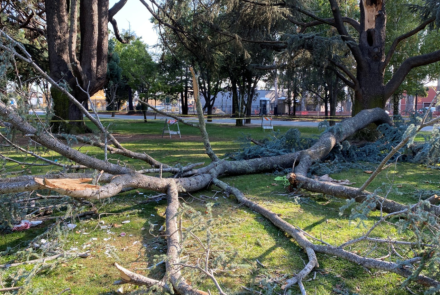Tree Accidents

Seemingly harmless, trees can lead to injury or death. It’s common to wake up after a windy and stormy night in San Francisco to find downed trees and broken tree branches in the roadway, in bicycle paths, and on top of parked vehicles throughout the city, especially near San Francisco’s Golden Gate Park and Panhandle. Because there are no obvious warning signs to a tree’s weakness, tree branch failure may cause serious and life threatening injuries.
Nature is not the only one to blame for tree injuries; improper maintenance or negligent inspection systems are often the cause of the tree’s falling limb or trunk. Different types of trees have unique trimming, pruning, and inspection standards and if they are not followed, weaknesses can develop. Weather patterns, such as drought or windy conditions, can contribute to a tree’s dangerous condition, requiring more frequent or specialized maintenance and inspection programs.
Common Factors Leading to Limb Failures
• Bark inclusion, a progressive condition which weakens the structural connection between trunk and branch
• Improper pruning, such as a topping cut
• Top heavy trees or branches
• Tree diseases
• Tree rot
• Tree age
• Tree insect damage
• Over-watering
• Failure to prune
• Weather conditions such as, drought or windy conditions
• Improper planting of a tree
• Prior limb failures
Although any type of tree can pose a hazard, common types of trees found growing in the Bay Area that can be dangerous include Eucalyptus trees, Cedar trees, Oak trees, Bay Laurel trees, Willow trees, the California Buckeye, and Redwood Trees.
Common Tree Accident Injuries
• Spinal injury
• Broken bones
• Skull Fracture
• Concussion
• Death
• Paralysis
Who Pays for Damages Caused by Dangerous Trees?
Liability in California for tree branch failure cases is based on premises liability and the theory that the tree and/or tree with a broken branch is a dangerous condition of property. Public entities, property owners, property lessors, or private property tenants, including business owners, may be held responsible for tree accidents when the owner or property occupier was negligent in the way they used or maintained the property.
If the land owner/occupier where the tree is located created a tree’s dangerous condition, or knew/ should have known about the tree’s condition and failed to fix it or warn about it, then the owner/occupier may be found at fault for the limb or trunk failure.
There are also local laws that require land owners and occupiers to maintain their properties in a reasonably safe condition. Failure to follow these may result in liability.
California Statutes and Local Ordinances Relevant to Bay Area Tree Injury Cases
California law, including the California Civil Code and local municipal law where the tree accident occurred governs liability for tree accident cases.
Relevant California Statutes related to tree accident cases include the following:
• California Civil Code section 833, which states “Trees whose trunks stand wholly upon the land of one owner belong exclusively to him, although their roots grow into the land of another.”
• California Civil Code section 834, which states “Trees whose trunks stand partly on the land of two or more coterminous owners, belong to them in common.”
• California Government Code Section 835 controls the liability of public entities, who may be found at fault if they knew or should have known of a dangerous tree or if they caused the tree to be dangerous.
• San Francisco’s Public Works Code, Article 16, section 805, states that with several exceptions, it is the City’s responsibility to maintain street trees, while it is the private property owner’s responsibility to maintain the sidewalk and sidewalk areas adjacent to the street tree.
Because there are several exceptions to these sections, it’s a good idea to consult an attorney for a deeper understanding.
Tree Accidents are Preventable
The tree accident lawyers of Meisel Law Group recommend hiring an arborist to inspect, maintain, repair, or remove hazardous trees on your property. You should also check your local ordinance to ensure you understand your maintenance responsibilities on or near your property. Depending on local ordinance you and/or the City or County may be responsible for maintaining the trees on/or abutting your property.
Contact an Experienced Tree Accident Lawyer
These cases are typically complex and involve understanding California and local law and familiarity with California tree case law. Multiple parties may be at fault for tree injuries as trees can be owned by multiple property owners and/or trees may grow on a property owned by one party but managed or maintained by another. Even tree accidents that occur on adjacent property can be found to be the owner or occupier’s responsibility. Your local ordinances will also impact the potential parties at fault and their responsibilities.
The tree accident lawyers of Meisel Law Group have extensive tree accident experience and a record of success when it comes to serious tree injury cases. Read about the 35 million dollar tree branch failure settlement reached in the City of Burlingame here and the 1.875 million tree accident settlement in Sacramento here. Contact us if you or a loved one has been injured by a falling tree or falling tree branch. We offer free consultation and we always work on a contingency basis (no fee or reimbursement of costs unless there is a recovery).
